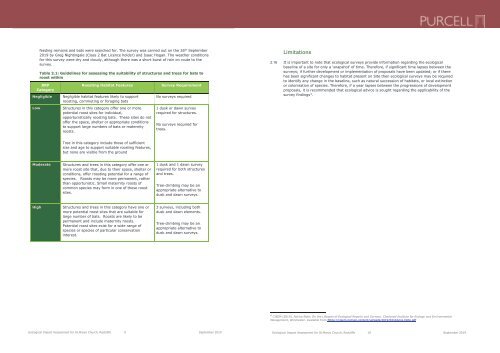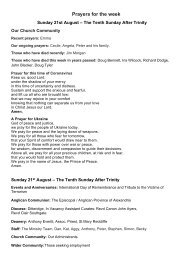St Mary Redcliffe Project 450 RIBA 2 Stage End Report
You also want an ePaper? Increase the reach of your titles
YUMPU automatically turns print PDFs into web optimized ePapers that Google loves.
feeding remains and bats were searched for. The survey was carried out on the 26 th September<br />
2019 by Greg Nightingale (Class 2 Bat Licence holder) and Isaac Hogan. The weather conditions<br />
for this survey were dry and cloudy, although there was a short burst of rain on route to the<br />
survey.<br />
Table 2.1: Guidelines for assessing the suitability of structures and trees for bats to<br />
roost within<br />
BRP<br />
Category<br />
Negligible<br />
Low<br />
Roosting Habitat Features<br />
Negligible habitat features likely to support<br />
roosting, commuting or foraging bats<br />
<strong>St</strong>ructures in this category offer one or more<br />
potential roost sites for individual,<br />
opportunistically roosting bats. These sites do not<br />
offer the space, shelter or appropriate conditions<br />
to support large numbers of bats or maternity<br />
roosts.<br />
Survey Requirement<br />
No surveys required<br />
1 dusk or dawn survey<br />
required for structures.<br />
No surveys required for<br />
trees.<br />
Limitations<br />
2.16 It is important to note that ecological surveys provide information regarding the ecological<br />
baseline of a site for only a ‘snapshot’ of time. Therefore, if significant time lapses between the<br />
surveys; if further development or implementation of proposals have been updated; or if there<br />
has been significant changes to habitat present on Site then ecological surveys may be required<br />
to identify any change in the baseline, such as natural succession of habitats, or local extinction<br />
or colonisation of species. Therefore, if a year lapses between the progressions of development<br />
proposals, it is recommended that ecological advice is sought regarding the applicability of the<br />
survey findings 4 .<br />
Tree in this category include those of sufficient<br />
size and age to support suitable roosting features,<br />
but none are visible from the ground<br />
Moderate<br />
<strong>St</strong>ructures and trees in this category offer one or<br />
more roost site that, due to their space, shelter or<br />
conditions, offer roosting potential for a range of<br />
species. Roosts may be more permanent, rather<br />
than opportunistic. Small maternity roosts of<br />
common species may form in one of these roost<br />
sites.<br />
1 dusk and 1 dawn survey<br />
required for both structures<br />
and trees.<br />
Tree-climbing may be an<br />
appropriate alternative to<br />
dusk and dawn surveys.<br />
High<br />
<strong>St</strong>ructures and trees in this category have one or<br />
more potential roost sites that are suitable for<br />
large number of bats. Roosts are likely to be<br />
permanent and include maternity roosts.<br />
Potential roost sites exist for a wide range of<br />
species or species of particular conservation<br />
interest.<br />
3 surveys, including both<br />
dusk and dawn elements.<br />
Tree-climbing may be an<br />
appropriate alternative to<br />
dusk and dawn surveys.<br />
4 CIEEM (2019). Advice Note: On the Lifespan of Ecological <strong>Report</strong>s and Surveys. Chartered Institute for Ecology and Environmental<br />
Management, Winchester. Available from:https://cieem.net/wp-content/uploads/2019/04/Advice-Note.pdf<br />
Ecological Impact Assessment for <strong>St</strong>.<strong>Mary</strong>s Church, <strong>Redcliffe</strong> 9 September 2019<br />
Ecological Impact Assessment for <strong>St</strong>.<strong>Mary</strong>s Church, <strong>Redcliffe</strong> 10 September 2019


















